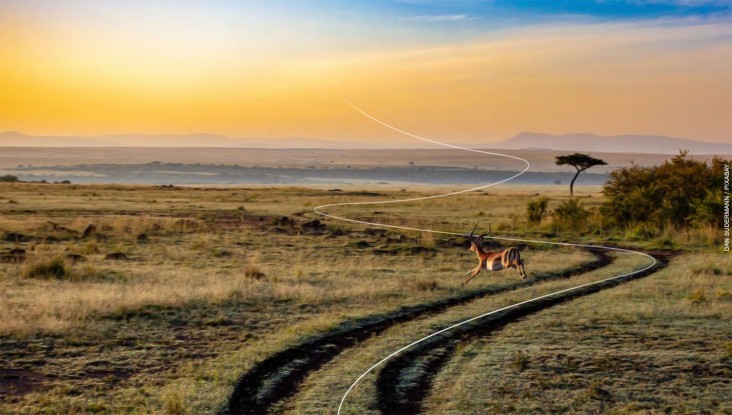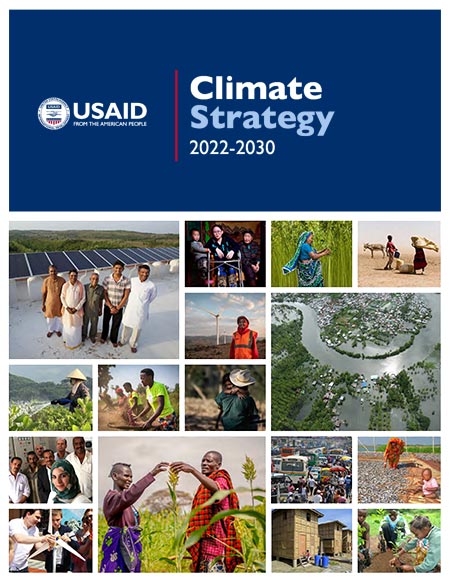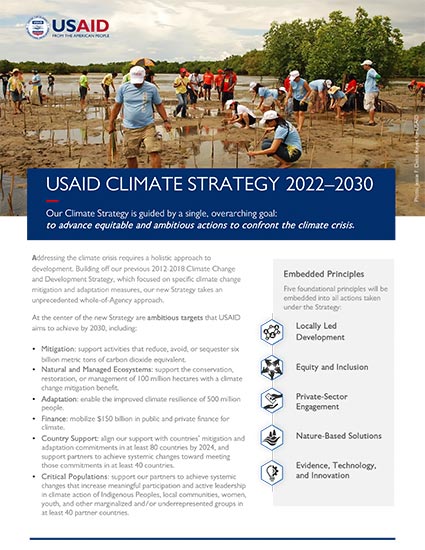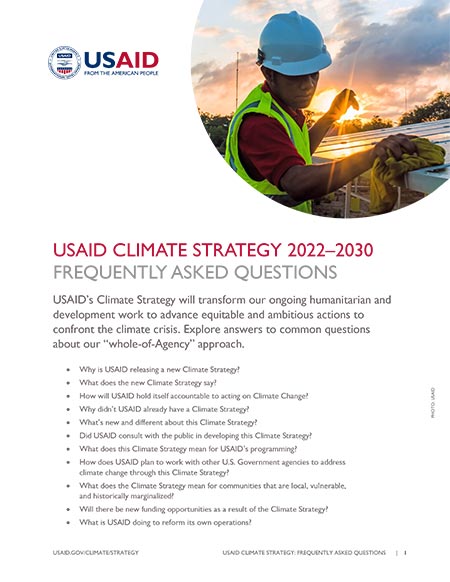- What We Do
- Agriculture and Food Security
- Anti-Corruption at USAID
- Climate Change
- Conflict Prevention and Stabilization
- Democracy, Human Rights, and Governance
- Economic Growth and Trade
- Education
- Environment, Energy, and Infrastructure
- Environmental and Natural Resource Management Framework
- Climate Change
- Conserving Biodiversity
- Energy
- Infrastructure
- Sustainable Urbanization
- Land Tenure and Property Rights
- Earth Day 2021
- Environmental Procedures Hub
- Environmental and Social Risk Management
- Tropical Forest and Coral Reef Conservation Act
- Environmental Policy Roadmap
- Gender Equality and Women's Empowerment
- Global Health
- Humanitarian Assistance
- Innovation, Technology, and Research
- Nutrition
- Water and Sanitation
Speeches Shim

Advancing Equitable and Ambitious Actions to Confront the Climate Crisis
USAID’s 2022–2030 Climate Strategy guides our whole-of-Agency approach to reduce global greenhouse gas emissions, help partner countries build resilience to climate change, and improve our operations.
Climate change is a global crisis. As temperatures and sea levels rise, people around the world are increasingly seeing heat waves, droughts, floods, cyclones, and wildfires upend their lives. Climate change disproportionately impacts people living in poverty and who are marginalized. It also affects virtually everything that USAID does and threatens the development progress we have supported for more than 60 years.
A Comprehensive Strategy
This decade will be decisive for the future of our planet. That is why USAID has developed a new Climate Strategy that will guide our humanitarian and development work through 2030 in a way that is truly different: by calling on all corners of USAID to play a part in our whole-of-Agency response.
USAID Climate Strategy 2022–2030 ![]() (pdf - 5 MB)
(pdf - 5 MB)
USAID Climate Strategy 2022–2030 ![]() (pdf - 5 MB)
(pdf - 5 MB)
Estrategia Climática de la USAID 2022–2030 ![]() (pdf - 5 MB)
(pdf - 5 MB)
Stratégie climat de l'USAID 2022–2030 ![]() (pdf - 2 MB)
(pdf - 2 MB)
Six Ambitious Targets
We have developed six high-level, ambitious targets for achievement by 2030 to hold ourselves accountable and demonstrate how a whole-of-agency approach can dramatically increase our impact.
Mitigation
6 Billion tCO2e
Partner with countries to support activities that reduce, avoid, or sequester six billion metric tons of carbon dioxide equivalent. This cumulative amount is roughly equal to total U.S. domestic emissions for one year or the equivalent of removing more than 1 billion gasoline powered cars from the road for one year.
Natural and Managed Ecosystems
100 Million Hectares
Support the conservation, restoration, or management of 100 million hectares with a climate mitigation benefit. That’s an area more than twice the size of California.
Adaptation
500 Million People
Enable the improved climate resilience of 500 million people. Through this work, we will be co-leading implementation of the whole-of-government President’s Emergency Plan for Adaptation and Resilience (PREPARE) initiative.
Finance
$150 Billion
Mobilize $150 billion in public and private finance for climate.
Country Support
80 Countries
Align our development portfolios with countries’ climate change mitigation and adaptation commitments in at least 80 countries by 2024, and will support our partners to achieve systemic changes toward meeting those commitments in at least 40 countries.
Critical Populations
40 Countries
Support our partners to achieve systemic changes that increase meaningful participation and active leadership in climate action of Indigenous Peoples, local communities, women, youth, and other marginalized and/or underrepresented groups in at least 40 partner countries.
Principles
This Strategy is built on several foundational principles, which will be incorporated into all planning and activities.
Locally Led Development
Support sustainable and equitable climate actions that are locally led, owned, and implemented, and tailored and context appropriate.
Equity and Inclusion
Center actions in the context of the diverse communities in which we work, and engage local, marginalized, and underrepresented groups as critical agents of change.
Private-Sector Engagement
Partner with the private sector to expand the scale, impact, and sustainability of our programs.
Nature-Based Solutions
Elevate nature-based solutions as key tools to absorb carbon, reduce disaster risk, support livelihoods, and improve food and water security.
Evidence and Innovation
Support the rigorous research, technology and development needed to identify and deploy effective climate solutions, including those locally known and developed.
A Participatory Process
USAID’s Climate Strategy was developed through a highly participatory process throughout 2021 and into 2022. We held more than 40 listening sessions with key stakeholders prior to drafting and we received over 2,800 comments on the draft we released for public consultation in November 2021. We have carefully reviewed, considered, and incorporated all of this feedback into the Strategy.
LEARN MORE
USAID Climate Strategy Resource Hub
CLIMATELINKS.ORG – This resource hub, hosted on Climatelinks, supporting the implementation of USAID’s Climate Strategy 2022–2030 provides sector-specific information, including technical guidance, knowledge resources, and tools.
Last updated: July 20, 2022





Comment
Make a general inquiry or suggest an improvement.